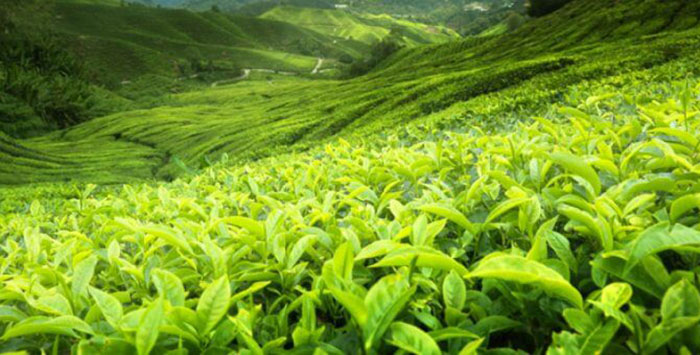Features
My continuing battle against the Tea Hub proposal that would have debased pure Ceylon Tea

Multinationals have long reduced the content of Ceylon tea in packs branded as such
(Excerpted from the autobiography of Merrill J. Fernando)
The ruthless philosophy of the multinational packer and retail supplier is to buy low and sell high in mass markets in which the consumer, through relentless advertising and promotion, has been compelled to accept a well-packaged mediocrity masquerading as excellence. The intrinsic value of a product such as Pure Ceylon Tea and its inherent value proposition is subordinated to profit. Concepts such as genuine product purity and uniqueness of origin have no place in such a world. Such values do not belong in the base culture of mass-marketing of bland, homogeneous products.
The importation of cheap tea from multiple origins would immediately result in the discounting, at the Colombo Auction, of equivalent grades produced in this country, which would invariably be of a higher value than the import. In fact, the cost of any cheap imported tea would be well below our national cost of production, which, for a number of well known reasons, is the highest in the world.
A glut of such low-priced imported tea would depress auction prices overall and adversely impact the grower and producer, who are already burdened by high production costs and diminishing land and worker productivity. In the meantime, the cheap blend, with its desirability enhanced by the legend ‘packed in Sri Lanka/Ceylon,’ will be perceived as genuine Ceylon Tea by the overseas consumer. That perception will cause irreparable damage to the image of Pure Ceylon Tea and, also, to the exporter of the genuine product.
Despite the many abuses it has been subject to over the years, at the hands of multinationals and other traders, who have no respect for either purity or origins, Ceylon Tea is not a commodity as other teas are. Pure Ceylon Tea, of itself and in itself, is a brand and a specialty in the eyes of the consumer. There is no other tea in the world which is recognized internationally by the country of its origin like Ceylon Tea; nor is any other country globally identified by the tea it produces like Sri Lanka/Ceylon.
Up to about 20 years ago, Ceylon Tea was promoted and marketed on that unique value proposition and that memory still lingers in the minds of the older, middle-aged consumer. It was that memory of quality which ensured the success of Dilmah in Australia, despite it being priced well above its competing brands produced by the big multinationals.
Historically, though, commoditization has been the strategy of the trader, the promotion of the brand on the strength of the quality image of Ceylon Tea and then gradually reducing the latter component, thus deluding the overseas consumer and impoverishing the local farmer. Consumers who purchase blindly on brand loyalty do not perceive the gradual erosion in the quality of the cup of tea they drink every day. They will continue to patronize the debased product as a conditioned reflex to compelling advertising and promotion.
A recent example of the strategy described above is the fate of the Russian market, first serviced by our own traders, who, instead of developing own labels when the opportunity arose, chose the easy path and became servitors of the foreign label. The end result was an ignominious exit from the market when the Russian buyer, having established market share on the strength of Ceylon Tea, took his business elsewhere or established his own packing plants in Russia itself.
Value addition, branding, and marketing have, for long, been the weakest features in our export field. Despite all their arguments to the contrary, increasing the total value of our exports using cheap imported tea is not practically possible. The immediate result would be the decline of the export price of Pure Ceylon Tea.
Value-added tea is already being exported at prices ranging from Rs. 600 per kg to Rs. 1,100 per kg. The availability of Ceylon Tea at those prices, automatically weakens the argument for importation of cheap tea, unless the purpose is simply to devalue the export price.
It is also most unlikely that global players in the tea trade, packing in-market, using cheap, multi-origin tea, would rush to Sri Lanka to establish packing centres with the establishment of a Tea Hub. We are far removed from the main markets of the global packers and the only inducements for them to set up operations in Sri Lanka would be the availability of low-cost labour and cheap tea, at rock-bottom prices, the margin savings overriding other disadvantages, such as additional shipping and distribution costs. Such operators will not buy the high-priced Ceylon Tea, unless the proposed massive influx of imported tea drives the local auction prices down to the floor! Is it necessary to emphasize that such a scenario would be the death knell for the local producer?
Unacceptable comparisons, Garment Sector vs. Tea Export Industry
Blending hubs such as Dubai and Rotterdam, examples frequently used by the Tea Hub proponents as ideal models for replication, cannot be equated with Sri Lanka, which is a major producer. Such hubs are commercial centers which facilitate the recycling of products from multiple origins and owe no allegiance to producing countries.
As for the much-touted increase in employment generated by a Tea Hub, it is a myth, as any new blending or packing plant would be fully automated and designed specifically to minimize manual labour. In an industrialized world relentlessly driving towards robotization of processes, manpower is the first designated casualty in any new venture.
The loss of traditional markets for our tea has not been due to price concerns, but largely due to our inadequacies in value addition, marketing, and promotion. The emergence of ‘Dilmah’ as a premier product in Australia and New Zealand, despite being much higher in price than the corresponding products from large multinationals, is proof of the effectiveness of product promotion on the intrinsic strengths of the product itself. It completely negates the argument that multi-origin, cheap blends will override the uniqueness of Pure Ceylon Tea on cost alone.
Our tea has for long been acclaimed as the ‘cleanest tea in the world,’ meeting the Minimum Residue Levels (MRL) stipulated by some of the most demanding markets in the world, such as Japan. The importation of cheap tea from multiple origins, of unregulated hygiene and cleanliness standards, would immediately defile that image irrevocably.
The garment sector in Sri Lanka and the establishment of special Free Trade Zones (FTZs) have been quoted by the TEA (Tea Export Association) as successful examples of special manufacturing enclaves, equivalent to the proposed Tea Hub. In my view those are most inappropriate comparisons, as unacceptable as a ‘chalk and cheese’ equivalent.
The apparel industry exists almost entirely for the servicing of foreign labels, with 95% of the components being imported, whilst, locally, we simply supply the labor. It is. essentially, a massive labor- intensive operation, dedicated to the concept of maximum production at the lowest cost, but embellished with attractive labels, supported by cutting-edge technology, best manufacturing practices, and compliance with international standards, process hygiene and worker safety.
I am not, even for one moment, belittling the success of the garment industry in Sri Lanka, but those are the realities. Sri Lankans do not own the garment industry and are almost entirely dependent on foreign label patronage for continued existence. In that respect alone, the garment industry in Sri Lanka is very similar to the foreign label service provided by Sri Lankan traders to multi-national tea packers. The establishment of a Tea Hub will relegate our tea industry to that unattractive niche. As long as we are in control of the production of the raw material, we have the power to strategize how and where we sell it and at what price.
The establishment of FTZs was to ensure that the finished product, or the raw material, is not leaked out to local markets. As opposed to that, in the plantation industry, possibly over 95% of the raw material and other components are generated locally. It is a totally home-grown industry where the raw material, in its totality, is produced within.
There are only two sustainable ways of increasing the export value of our tea. One is to improve our land and labour productivity and increase annual production and, thus, send more tea to the auction annually. Another is to increase value addition at source to locally-owned brands, thus enhancing the export price. In fact, simply increasing production without a parallel strategy for adding value is also counterproductive.
Auction prices are determined by supply/ demand dynamics which are outside the producers’ area of control and a combination of both volume and quality will not ensure a sustainable revenue increase. Finally, value addition at source to a good quality finished product, namely ‘Pure Ceylon Tea,’ is the surest method of increasing earnings.
Every kilo of tea produced in Ceylon sells at premium prices and, irrespective of other market dynamics, is still considered as a benchmark for overall quality. In such a scenario, the only objective of devaluing it would be for personal gain, in order to compete with the mass-selling, low-priced, multinational trader.
Example of exploitation
The multinational traders’ exploitative strategy in regard to third world products is best illustrated by coffee, grown in countries such as Brazil, Vietnam, Colombia, Ethiopia, Uganda, and many other countries in Africa. In all the countries where coffee is grown in volume, the per capita income of the farmer is a fraction of that of an average farmer in a developed country and miniscule in comparison to the earnings of the average coffee consumer in the West.
Colvin R. de Silva, as Minister of Plantations, was one of the first politicians to publicly and unequivocally articulate this unacceptable disparity. For every plastic cup of coffee sold for USD 3-4 in affluent societies, the farmer in Africa gets five cents. From a kilogramme of coffee sold at USD 2.75, 110 cups can be brewed, translating to a profit margin of over USD 300 for those in between the poor farmer and the rich consumer.
The story of the tea trade in the hands of the multinational tea trader is no different and the cheapening of Ceylon Tea by importing, blending, and re-exporting will contribute further to that unacceptable social and economic disequilibrium.
It is a cardinal rule of all major packers – multinationals – never to purchase their material from one source or origin. Invariably they operate through two or more suppliers. However, because of the excellent and longstanding quality proposition of Ceylon Tea and the confidence we inspired in all the buyers of the major retailers, for many decades Ceylon Tea used to be, if not the major component, the most important ingredient of multinational packs.
Disappointing indications
During a previous Government’s term, the then Finance Minister, Ravi Karunanayake, deluded by the facile arguments of the Tea Hub proponents, facilitated the importation of tea in one of his budgets.
However, my protests against this provision, supported by the then Minister, Ranil Wickremesinghe, resulted in its removal.
I must also admit to being disappointed by the stance of the Planters’ Association, in regard to the issue of the Tea Hub. I recall a strongly-worded press statement (Daily FT, May 17, 2012), in which the PA declared its opposition to the concept. However, as the umbrella body which primarily represents producer interests, I would have expected it to come out far more strongly, vocally, and actively, against an initiative with the very obvious potential to cause serious damage producer.
Sometime in March 2012, immediately after a meeting of the anvil, chaired by me, certain members of the Tea Council met then Plantations Minister, Mahinda Samarasinghe, and advised him that they would boycott future meetings of the Council chaired by me if I continued to oppose the TEA proposals regarding importation of tea. However, they did not breathe a word about this matter at the meeting itself, though that was the most obvious forum for the issue to have been discussed.
Frankly, I was disgusted by the base conduct of those exporters and, by my letter of March 30, 2012, addressed to Minister Samarasinghe, I resigned from the chairmanship of the Council. In my letter I also clearly stated the reasons for my resignation. The Minister accepted it and appointed Tyeab Akberally, Vice Chairman, to the position I relinquished.
The Tea Council was set up in 1989, under the direction of the then Minister of Plantations, Gamini Dissanayake. Its core purpose was resolving the many problems of the entire industry, in a manner that would benefit the industry in its totality; the plantation worker, the producer, the broker, and the exporter, all included. The very submission of a proposal which only addressed the interests of the exporter, to the obvious detriment of all other stakeholders, was in conflict with the remit of the Council.
Dr. P. B. Jayasundera, then Secretary to the Treasury, has always been a strong opponent of the Tea Hub concept. Addressing the CTTA’s 118th Annual General Meeting in late 2012, ironically flanked at the head table by a couple of ardent proponents of the Tea Hub concept, Dr. Jayasundera stated quite unequivocally that the only manner in which the export earnings from tea could be increased was by “creating a new development framework and promoting Ceylon Tea at a premium, setting aside the idea of making the country a Tea Hub”.
Basically, what Dr. Jayasundera supported was to position Sri Lanka as an exclusive centre for value addition to Pure Ceylon Tea and not to convert it to a trading platform for tea from any and every origin.
Bleak certainties
To any impartial observer, it would be clear that the TEA call for liberalization of imports was driven by the sense of insecurity, generated by the rapidly-diminishing profit margins of the proponents. It is a proposal which reflects, with embarrassing clarity, the mindset of the timid exporter and his submission to foreign label pressure. In my many arguments against the Hub, I have frequently requested its supporters to take a moment to consider why a few exporters from Sri Lanka sell comfortably at USD 10 FOB per kilo, whilst others scramble at the bottom, selling at USD 3 per kilo.
All the multinationals operating in Sri Lanka are now manned entirely by Sri Lankans and the industry’s reliance on the former to market our tea should be minimal. However, I am both baffled and saddened by the still very evident orientation and adherence within the industry to archaic multinational thinking and strategy.
In their hunger for short-term gain, the proponents of the Tea Hub are prepared to sacrifice the long-term potential of Pure Ceylon Tea, as well as consign the hundreds of thousands of low-income earners at the producers’ end to permanent impoverishment. In their pursuit of immediate and short term survival, they are prepared to surrender every natural advantage in ‘Pure Ceylon Tea’. The reality is that it is the locally-owned brands exporting exclusively ‘Pure Ceylon Tea,’ which are the flag bearers of the national product on the global stage.
In total, about 12% of this country’s population is dependent, either directly or indirectly, on the plantation economy. Of that proportion, about 90% toil at the producers’ end; plantation workers and residents, small-holders, their dependents, ancillary service suppliers, bought leaf manufacturers, and so on. A decline in the Colombo tea prices, arising from cheap imports, would result in a permanent adverse impact on the lives of this multitude, whilst temporarily enriching a minuscule proportion at the exporters’ end.
Pure Ceylon Tea was, and still is, this country’s greatest asset. It’s a primary home-grown product and identifies Ceylon/Sri Lanka globally. Its real value and significance have either been misinterpreted by successive governments, and many of our local traders, but fully exploited by the multinational who understood its actual worth. Through Ceylon Tea, the country has a product which can stand alone and compete successfully against any tea grown or manufactured in any other country. The maximization of its inherent value proposition simply requires vision, dedication, and integrity of purpose.
For over a century we have permitted Ceylon Tea, a valuable and attractive ‘finished product’ with enormous potential to this country, to be exported by multinational companies to other countries as a ‘raw material’. The importing countries debase its natural quality by blending with inferior tea from other origins, whilst reducing its cost and, with pretty packaging, claim to add value to a less-than-mediocre mix, but still sell it on its intrinsic value as Ceylon Tea. In the process, the tea that is grown by the farmer in our country enriches a chain which has no real link to his country, at the expense of our producer, our farmer, and our plantation worker.
What the proponents of the Tea Hub are advocating so strongly is the replication of the same odious process, in the country of the orign of Ceylon Tea, though they have clothed the proposal in noble rhetoric, as a panacea for all the ills of the tea industry.
Pure Ceylon Tea is still synonymous with quality in the many countries in which it has been a traditional brew, despite the debasement it has suffered at the hands of multinationals who, whilst devaluing its intrinsic goodness, still leveraged the original quality perception in their marketing. Thus, packers determine the quality that they offer the consumer, as the purchasing choice of the latter is limited to what is available on the supermarket shelf.
This compulsion created by the multi-national marketer appears to have created an illusory perception in the minds of certain exporters, especially the Tea Hub proponents, that the cheap, debased tea is actually a consumer demand or preference. Dilmah, however, convincingly exploded this myth with its success in the marketing of quality ‘Pure Ceylon Tea’ in Australia and New Zealand.
Marshalling the opposition
At the beginning of this chapter I referred to the proposal by the then Trade Minister, Lalith Athulathmudali, in 1979, which, to the best of my knowledge, was the first instance when a leading politician presented tea importation as a strategy with potential for economic benefit to the country. To the best of my recollection, there had been no serious discussion about it before, although I am certain that the idea would have been tossed around in tea trading circles. It is really in the 1980s that wider discussion around the concept commenced, eventually gathering momentum until, within a couple of decades, it became an existential threat to the tea industry in its totality.
When I first opposed Athulathmudali’s proposal, I was, essentially, a bulk tea exporter. Dilmah arrived almost 10 years later. Thus, it must be clear to all readers that my opposition to the concept of a Tea Hub, contrary to the arguments of my opponents, was not to protect my interests or my personal brand, but entirely in the larger interests of the tea industry of Sri Lanka. It is for that reason that in this writing I have explained in considerable detail the likely impact of the implementation of such a proposal.
In the years since 2010, during which the Tea Hub proposal has been canvassed by its advocates at all relevant forums, I have used all the resources that I was able to muster to oppose it. My views have been expressed publicly, via newspapers and the electronic media, whilst concurrently being made known at the highest levels of government. I was also able to enlist the support of the Tea Small Holders’ Association and the assistance of the Private Tea Factory Owners’ Association, whilst the Planters’ Association also endorsed my view. However, as I have said earlier in this writing, from the latter I would have welcomed a far more involved engagement in opposition given that, in the event of unrestricted importation, the producer stood to lose more than any other industry group.
Independent journalists of several newspapers, both Sinhala and English, also published articles in support. My friend Herman Gunaratne, plantation owner and specialty tea producer-exporter from Galle, with his passion for Pure Ceylon Tea and his wide contacts within the smallholder segment and private factory owners of the south, was of immense help to me in marshalling support in resistance of the Tea Hub proposal.
The combined strength of the opposition groups, representing about 12% of the country’s population, eventually succeeded in temporarily suppressing a scheme which would have briefly benefited a few thousand people at most. However, the industry needs to be always aware of and be constantly on guard against a resurgence of the Tea Hub movement. If implemented, it will be, for a short while, very profitable for the proponents who are only interested in short-term gain. Since there is money in it, albeit for a handful of profiteers, I suspect that the idea will never be abandoned altogether, irrespective of opposition.
The Tea Hub proposition is a delusional attempt to bridge the chasm between the supplier of tea and the marketer of tea. It is a futile exercise to conflate these two mutually-exclusive concepts. The supplier furnishes a featureless commodity whilst the marketer markets a branded product with a specific identity. There can never connection between these two extremes. Finally, despite all opposition, if the Hub eventually becomes a dismal reality, and the local tea industry collapses as a result – as it surely will – there will not be one expert at that time to acknowledge responsibility and openly say, “Yes, I supported the importation of Orthodox Tea!”
Features
Kashmir terror attack underscores need for South Asian stability and amity

 The most urgent need for the South Asian region right now, in the wake of the cold-blooded killing by gunmen of nearly 30 local tourists in Indian-administered Kashmir two days back, is the initiation of measures that could ensure regional stability and peace. The state actors that matter most in this situation are India and Pakistan and it would be in the best interests of the region for both countries to stringently refrain from succumbing to knee-jerk reactions in the face of any perceived provocations arising from the bloodshed.
The most urgent need for the South Asian region right now, in the wake of the cold-blooded killing by gunmen of nearly 30 local tourists in Indian-administered Kashmir two days back, is the initiation of measures that could ensure regional stability and peace. The state actors that matter most in this situation are India and Pakistan and it would be in the best interests of the region for both countries to stringently refrain from succumbing to knee-jerk reactions in the face of any perceived provocations arising from the bloodshed.
The consequences for the countries concerned and the region could be grave if the terror incident leads to stepped-up friction and hostility between India and Pakistan. Some hardline elements in India, for instance, are on record in the international media as calling on the Indian state to initiate tough military action against Pakistan for the Kashmiri terror in question and a positive response to such urgings could even lead to a new India-Pakistan war.
Those wishing South Asia well are likely to advocate maximum restraint by both states and call for negotiations by them to avert any military stand-offs and conflicts that could prove counter-productive for all quarters concerned. This columnist lends his pen to such advocacy.
Right now in Sri Lanka, nationalistic elements in the country’s South in particular are splitting hairs over an MoU relating to security cooperation Sri Lanka has signed with India. Essentially, the main line of speculation among these sections is that Sri Lanka is coming under the suzerainty of India, so to speak, in the security sphere and would be under its dictates in the handling of its security interests. In the process, these nationalistic sections are giving fresh life to the deep-seated anti-India phobia among sections of the Sri Lankan public. The eventual result will be heightened, irrational hostility towards India among vulnerable, unenlightened Sri Lankans.
Nothing new will be said if the point is made that such irrational fears with respect to India are particularly marked among India’s smaller neighbouring states and their publics. Needless to say, collective fears of this kind only lead to perpetually strained relations between India and her neighbours, resulting in regional disunity, which, of course would not be in South Asia’s best interests.
SAARC is seen as ‘dead’ by some sections in South Asia and its present dysfunctional nature seems to give credence to this belief. Continued friction between India and Pakistan is seen as playing a major role in such inner paralysis and this is, no doubt, the main causative factor in SARRC’s current seeming ineffectiveness.
However, the widespread anti-India phobia referred to needs to be factored in as playing a role in SAARC’s lack of dynamism and ‘life’ as well. If democratic governments go some distance in exorcising such anti-Indianism from their people’s psyches, some progress could be made in restoring SAARC to ‘life’ and the latter could then play a constructive role in defusing India-Pakistan tensions.
It does not follow that if SAARC was ‘alive and well’, security related incidents of the kind that were witnessed in India-administered Kashmir recently would not occur. This is far from being the case, but if SAARC was fully operational, the states concerned would be in possession of the means and channels of resolving the issues that flow from such crises with greater amicability and mutual accommodation.
Accordingly, the South Asian Eight would be acting in their interests by seeking to restore SAARC back to ‘life’. An essential task in this process is the elimination of mutual fear and suspicion among the Eight and the states concerned need to do all that they could to eliminate any fixations and phobias that the countries have in relation to each other.
It does not follow from the foregoing that the SAARC Eight should not broad base their relations and pull back from fostering beneficial ties with extra-regional countries and groupings that have a bearing on their best interests. On the contrary, each SAARC country’s ties need to be wide-ranging and based on the principle that each such state would be a friend to all countries and an enemy of none as long as the latter are well-meaning.
The foregoing sharp focus on SAARC and its fortunes is necessitated by the consideration that the developmental issues in particular facing the region are best resolved by the region itself on the basis of its multiple material and intellectual resources. The grouping should not only be revived but a revisit should also be made to its past programs; particularly those which related to intra-regional conflict resolution. Thus, talking to each other under a new visionary commitment to SAARC collective wellbeing is crucially needed.
On the question of ties with India, it should be perceived by the latter’s smaller neighbours that there is no getting away from the need to foster increasingly closer relations with India, today a number one global power.
This should not amount to these smaller neighbours surrendering their rights and sovereignty to India. Far from it. On the contrary these smaller states should seek to craft mutually beneficial ties with India. It is a question of these small states following a truly Non-aligned foreign policy and using their best diplomatic and political skills to structure their ties with India in a way that would be mutually beneficial. It is up to these neighbours to cultivate the skills needed to meet these major challenges.
Going ahead, it will be in South Asia’s best interests to get SAARC back on its feet once again. If this aim is pursued with visionary zeal and if SAARC amity is sealed once and for all intra-regional friction and enmities could be put to rest. What smaller states should avoid scrupulously is the pitting of extra-regional powers against India and Pakistan in their squabbles with either of the latter. This practice has been pivotal in bringing strife and contention into South Asia and in dividing the region against itself.
Accordingly, the principal challenge facing South Asia is to be imbued once again with the SAARC spirit. The latter spirit’s healing powers need to be made real and enduring. Thus will we have a region truly united in brotherhood and peace.
Features
International schools …in action

 The British School in Colombo celebrated the 2025 Sinhala and Tamil New Year with the traditional rites and rituals and customs unique to the island nation, during a special Avurudu Assembly held at the school premises.
The British School in Colombo celebrated the 2025 Sinhala and Tamil New Year with the traditional rites and rituals and customs unique to the island nation, during a special Avurudu Assembly held at the school premises.
Students from all over the world, who are part of The British School in Colombo, gathered to celebrate this joyous event.
The special assembly featured traditional song and dance items from talented performers of both the Junior and Senior Schools.
On this particular day, the teachers and students were invited to attend school in Sri Lankan national costume and, among the traditional rituals celebrated, was the boiling of the milk and the tradition of Ganu-Denu.

Boiling of
the milk
In the meanwhile, a group of swimmers from Lyceum International School, Wattala, visited Australia to participate in the Global-ISE International Swimming Training Programme in Melbourne.
Over the course of 10 days, the swimmers followed an advanced training schedule and attended sessions at the Melbourne Sports and Aquatic Centre (MSAC), Victoria’s Nunawading Swimming Club, and Camberwell Grammar School.
In addition to their training, the group also explored Melbourne, with visits to key landmarks, such as the Parliament House and the Melbourne Cricket Ground (MCG), along with city tours and cultural experiences.

Traditional dance item

Tug-of-war contest

On arrival in Melbourne, Lyceum International School, Wattala, with Sri Lankan officials
Features
Perfect … and healthy

 Got a few more beauty tips to give you … for a perfect complexion, or, let’s say, a healthy skin.
Got a few more beauty tips to give you … for a perfect complexion, or, let’s say, a healthy skin.
* Honey Face Mask:
Take a tablespoon of raw honey and then warm it up by rubbing it with your fingertips. Apply the warm honey all over your face. Let this natural mask stand for about 10 minutes and then wash it off gently with warm water.
* Coconut Milk Face Mask:
You need to squeeze coconut milk out of a grated raw coconut and apply this milk all over your face, including your lips.
(This will help you gain a glowing skin. It is one of the best natural tips for skin care)
* Orange, Lemon, and Yoghurt Moisturiser:
To prepare this moisturiser, you need a tablespoon of orange juice, a tablespoon of lemon juice and a cup of plain yoghurt.
Mix them together and apply the paste all over your face, leaving it as a mask for 10 to 15 minutes. Next, take a damp handkerchief and use it to clean your face.
(This moisturiser brightens the complexion of your skin)
* Cucumber and Lemon:
Apply equal parts of cucumber and lemon juice on your face before taking a bath. Allow it to sit for 10 minutes before rinsing it off. This natural face beauty tip will brighten your skin tone and lighten blemishes if used on a regular basis. The best aspect is that it is appropriate for all skin types!
* Healthy Diet:
Aside from the effective home remedies, there are certain other factors to consider for skin care – and the first of them is your diet. Without the right nutrients, your skin cannot reverse the damage it suffers every day.
Eat fruits that are high in vitamin C because they contain antioxidants.
Adjust your diet to get the right amount of protein and unsaturated fats, as well as fresh green vegetables. All of this provides the right amount of nutrients so your skin can heal and improve itself naturally.
* Sun Protection and Care:
Another thing to keep in mind is not to step out of your home without sunscreen, especially with this awful heat we are experiencing at the moment. The hard rays of the sun can do you more damage than you could ever imagine.
By the way, you can prepare your own sunscreen lotion with glycerin, cucumber juice and rose water. You can also keep this lotion in the fridge.
-

 Business6 days ago
Business6 days agoDIMO pioneers major fleet expansion with Tata SIGNA Prime Movers for ILM
-

 News5 days ago
News5 days agoFamily discovers rare species thought to be extinct for over a century in home garden
-

 Features7 days ago
Features7 days agoProf. Lal Tennekoon: An illustrious but utterly unpretentious and much -loved academic
-

 Foreign News6 days ago
Foreign News6 days agoChina races robots against humans in Beijing half marathon
-

 Features3 days ago
Features3 days agoRuGoesWild: Taking science into the wild — and into the hearts of Sri Lankans
-

 Editorial6 days ago
Editorial6 days agoSelective use of PTA
-

 News3 days ago
News3 days agoOrders under the provisions of the Prevention of Corruptions Act No. 9 of 2023 for concurrence of parliament
-

 Features4 days ago
Features4 days agoNew species of Bronzeback snake, discovered in Sri Lanka


























